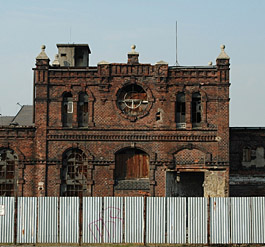
Ostrava is still striving for the city slaughterhouse designated as a cultural monument
 |
The city wants to build a connection between Bauhaus and the emerging district of Nová Karolina. Mayor Petr Kajnar (ČSSD) told reporters today that there are two options for building the connection. The city is willing to choose the more expensive option, which he believes would be more advantageous for the company. The statement from Bauhaus director Aleš Pacal could not be obtained by ČTK.
The city needs to connect Českobratrská Street with the newly developing Nová Karolina district, which is being constructed by Multi Development. The connection could lead through Janáčkova Street, thus between the slaughterhouses and Bauhaus, or between the department store and Českobratrská Street. "The second option is financially more demanding for the city, but in terms of development (of the area) it is beneficial for both the city and Bauhaus, which could have the land in one piece and could make better commercial use of it," said Kajnar.
He added that if the city chose the option that is roughly 13 million crowns more expensive, it would seek compensation from Bauhaus. "The difference could be invested by Bauhaus into the renovation of the slaughterhouses or it could offer the city some favorable price to enable the purchase of the slaughterhouses," explained Kajnar. However, the city must decide on one of the options within a few weeks. If an agreement with Bauhaus is not reached, a simpler option will be chosen.
"The slaughterhouses have become a symbol for the people of Ostrava, who feel with their hearts. Many people are fighting for them to be restored," said Kajnar. He reminded that the slaughterhouses are located near the famous Stodolní Street and could be used for music events or exhibitions, for example. "There could be some stand that would enhance the life of Stodolní Street, so it wouldn't just be about beer, but also provide some entertainment and culture at a decent level," added Kajnar, noting that negotiations for the acquisition of the slaughterhouses have been underway with the company for about three years.
A few days ago, one of the buildings in the slaughterhouse complex had to be demolished. It was a non-protected historical building that was in poor technical condition, which was further worsened by this year's winter and snow. The building's structure was compromised.
The historically and architecturally valuable complex of the municipal slaughterhouses made of brick is located between the railway line, Janáčkova, Pobialova, and Stodolní streets. It was built in 1881. The slaughterhouses operated until the 1970s, and a part of the structure was demolished in the 1990s.
The English translation is powered by AI tool. Switch to Czech to view the original text source.
0 comments
add comment
Related articles
0
25.11.2025 | The former hobby market in the center of Ostrava could be replaced by a judicial complex
0
02.07.2023 | In Ostrava, the first brownfield garden in the Czech Republic is blooming
0
16.05.2022 | In Ostrava, you can see the renovated building of the former slaughterhouse
2
04.03.2022 | In Ostrava, the reconstruction of the historic building of the former slaughterhouse is nearing completion
2
21.01.2022 | Ostrava Gallery Plato is preparing to move to the renovated slaughterhouse facility
0
14.09.2021 | Ostrava will sell a complex of properties adjacent to the former slaughterhouse building
0
11.10.2017 | The city of Ostrava will negotiate with the Poles regarding the contract for the project of transforming the slaughterhouse
0
22.06.2017 | Ostrava will buy a complex of houses near the historic slaughterhouse
0
24.05.2017 | Ostrava will present competition proposals for the reconstruction of the slaughterhouse
0
02.05.2017 | The competition for the transformation of the Ostrava slaughterhouse was won by the studio Petr Hájek Architekti
0
23.03.2017 | The proposals for the transformation of the historical slaughterhouse will be known in Ostrava in April
0
17.02.2017 | Conversion of the former slaughterhouse in Ostrava - announcement of an international competition
0
25.01.2017 | The representatives of Ostrava approved the conditions for the competition to repair the slaughterhouse
0
18.12.2016 | Historical slaughterhouse in Ostrava awaits inspection by heritage conservationists
0
16.11.2016 | Ostrava will announce an architectural competition for the renovation of the slaughterhouse
0
31.08.2016 | Ostrava will take over the historic city slaughterhouse
0
15.06.2016 | Ostrava is likely to regain the former city slaughterhouse after years of effort
0
16.01.2013 | The leadership of Ostrava is negotiating with Bauhaus about the purchase of the historic slaughterhouse











